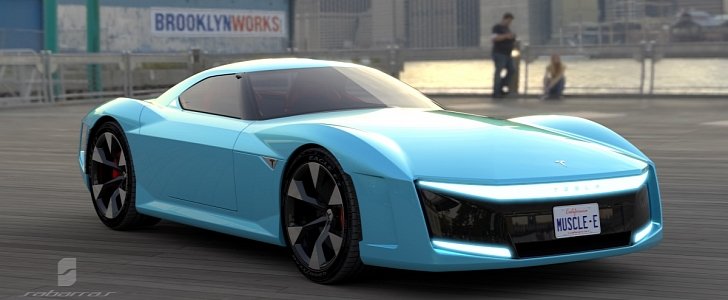Like peanut butter and jelly sandwiches, muscle cars represent the perfect marriage of a compact, light body and a powerful, feisty and loud V8. Now, if you’d like to imagine your sandwich with less flavor, you can simply take out the V8.
Muscle cars have iconic status and, even though it is widely considered that their heyday was several decades ago, they remain incredibly popular. There’s a reason why no electric vehicle maker has ever tried to emulate the classic form of a muscle car. For gearheads, turning a muscle car into an EV is probably the worst kind of abomination possible.
That said, what if…? What if Tesla’s Elon Musk woke up one day and thought to himself, “wouldn’t it be great if we made a muscle car?” Scott A. Barras from design firm SABARRAS imagines such a future and the kind of car that would result. He calls it the Tesla GT, the all-electric muscle car that pays homage to the glorious past of American automotive history, while looking towards a fully-electrified future.
Rendered both in hardtop and convertible forms, the Tesla GT takes some of the design language of the greatest muscle cars ever made, like the V8-powered ponies wearing the Camaro/Cuda/Challenger/Mustang nameplates, and repurposes it for a modern-day vehicle, keeping in mind “modern proportions and aerodynamics,” Barras explains. To further honor the inventor whose name the Tesla company is using, Barras included in the design of the GT Nikola Tesla’s obsession with the numbers 3, 6 and 9.
The goal was to create a “mean-looking” car in the styling of American muscle cars, while incorporating modern features like the battery pack and motors, regenerative braking and cameras inserted into the A-pillars instead of side mirrors.
To those asking themselves why anyone would come up with such a Frankenstein idea, Barras says this of his inspiration: “These days, sober looking Tesla sedans and crossovers are able to out accelerate all but the most expensive hypercars. […] Modern Tesla sedans and crossovers consistently embarrass highly modified muscle cars during races from junction stops. This inspired me to design a muscular, all-American style of electric sports car to attract muscle car buyers by offering the contemporary experience of chest crushing acceleration with a style that more reflects their personality.”
The question is now, would muscle car buyers go for an incomplete, perhaps not as tasty peanut and butter jelly sandwich instead of the real thing?
That said, what if…? What if Tesla’s Elon Musk woke up one day and thought to himself, “wouldn’t it be great if we made a muscle car?” Scott A. Barras from design firm SABARRAS imagines such a future and the kind of car that would result. He calls it the Tesla GT, the all-electric muscle car that pays homage to the glorious past of American automotive history, while looking towards a fully-electrified future.
Rendered both in hardtop and convertible forms, the Tesla GT takes some of the design language of the greatest muscle cars ever made, like the V8-powered ponies wearing the Camaro/Cuda/Challenger/Mustang nameplates, and repurposes it for a modern-day vehicle, keeping in mind “modern proportions and aerodynamics,” Barras explains. To further honor the inventor whose name the Tesla company is using, Barras included in the design of the GT Nikola Tesla’s obsession with the numbers 3, 6 and 9.
The goal was to create a “mean-looking” car in the styling of American muscle cars, while incorporating modern features like the battery pack and motors, regenerative braking and cameras inserted into the A-pillars instead of side mirrors.
To those asking themselves why anyone would come up with such a Frankenstein idea, Barras says this of his inspiration: “These days, sober looking Tesla sedans and crossovers are able to out accelerate all but the most expensive hypercars. […] Modern Tesla sedans and crossovers consistently embarrass highly modified muscle cars during races from junction stops. This inspired me to design a muscular, all-American style of electric sports car to attract muscle car buyers by offering the contemporary experience of chest crushing acceleration with a style that more reflects their personality.”
The question is now, would muscle car buyers go for an incomplete, perhaps not as tasty peanut and butter jelly sandwich instead of the real thing?












